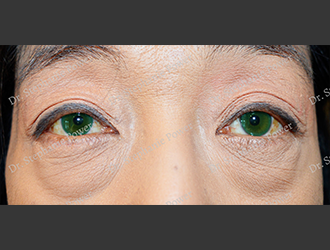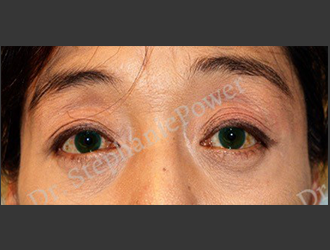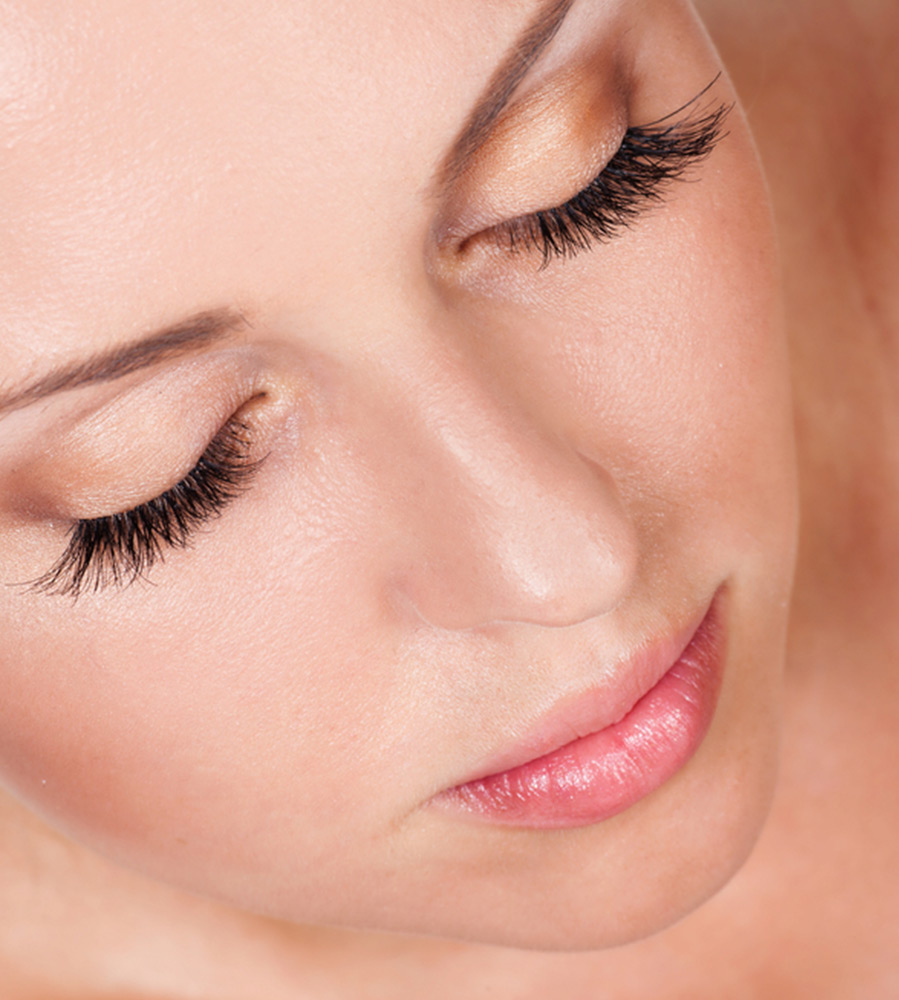BLEPHAROPLASTY AT POWER PLASTIC SURGERY
The eye region is one of the most common sites to show signs of facial aging. Many patients consider eye lift surgery to address loose skin that develops of the upper or lower lids. Aging in the periorbital (eye) region may lead to loose skin and increased prominence of orbital fat as elasticity decreases. Patients often complain of appearing fatigued and wish to achieve eyelid rejuvenation.
What is an eye lift?
Blepharoplasty or eye lift is a surgical procedure that may be performed on the upper and/or lower eyelids to redrape skin and to remove or reposition orbital fat. Incisions are designed within natural skin creases in order to minimize scar visibility following surgery.
Blepharoplasty is performed as outpatient surgery, most commonly under local anesthetic for an upper eye lift. Lower blepharoplasty or combined upper and lower eye lift is most commonly performed under general anesthetic given that it is a longer and more extensive surgery.
Blepharoplasty may be performed in combination with fat grafting for periorbital rejuvenation. This may smoothen the junction between the lower eyelid and cheek as well as restore volume in the midface.
What are common concerns of patients considering eye lift surgery?
Patients considering blepharoplasty commonly express concerns regarding signs of aging in the periorbital region, including loose eyelid skin and increased prominence of fatty tissue. Occasionally younger patients may present with excess upper eyelid skin in isolation, which may be hereditary. Patients often report appearing tired – even when well-rested – and older due to redundant eyelid skin and puffiness.
The most common cause of eyelid droopiness (ptosis) after blepharoplasty is unrecognized ptosis before surgery. It may become more apparent following removal of excess upper eyelid skin. Dr. Power will carefully assess your eyelid position and muscle function before surgery and will discuss if ptosis repair may be also be required.
It is also important to assess eyebrow position during consultation for upper eye lift. Sometimes brow ptosis may lead to the appearance of excess upper eyelid skin when in fact the lowered brow is the culprit. Browlift may be more appropriate in these cases to enhance periorbital rejuvenation.
Dr. Power will also ask if you have recently undergone Botox injections, which may affect the position of the brows. This is important to know during consultation for blepharoplasty, since the appearance of the upper lids may be affected by the action of Botox in the glabellar and forehead regions.
Who is a suitable candidate for an eye lift?
A suitable candidate for blepharoplasty expresses reasonable goals and expectations of surgery and is otherwise healthy or with well-controlled medical conditions. It is important to rule out underlying eye conditions (thyroid eye disease, in particular), which may lead to increased risk of complications following blepharoplasty.
What are different types of eye lift?
Eye lift may be performed on the upper, lower, or both lids based on aesthetic concerns and clinical presentation.
UPPER EYELID LIFT
During an upper eye lift, skin redundancy is removed through a small incision hidden in the upper lid crease. If patients also present with puffiness towards the inner eye region, orbital fat may also be removed during an upper eye lift.
LOWER EYELID LIFT
Lower eye lift is a more extensive procedure. For patients presenting only with lower lid puffiness and prominent fat, it may be possible to resect or reposition orbital fat through an incision hidden on the inner lid, called a transconjunctival approach. It is not possible to remove skin redundancy through this approach, so it applies to a select group of patients with bulging fat alone and no excess skin. If skin redundancy is also present, an external approach is used which places an incision just below the eye lashes of the lower lid (subciliary approach). A small extension is also required towards the side of the eye but confined within the orbital region to remove excess skin. This lateral (outer eye) extension is placed with a relaxed skin tension line and follows the natural creases in this region. This ensures that the scar will fade post-operatively. Through a subciliary approach the orbital fat is accessed and may be cautiously removed or repositioned based on the lower lid appearance and goals of surgery. Excess skin is then removed. Based on the lower lid tone, other procedures may be indicated to lower risk of complications post-operatively. The outer corner of the eye may be suspended and secured through a lateral canthopexy. To lower the risk of lower lid retraction during early healing, a temporary stitch is commonly secured between the upper and lower lids. This is performed towards the outer aspect of the lids to maintain central vision during early recovery. This temporary suture supports the lid during early healing to reduce swelling and may lower the risk of developing lower lid retraction. Based on pre-operative lower lid appearance, other techniques may be indicated, such as lower lid tightening procedures.
What to expect the day of eye lift surgery?
Please take any routine blood pressure medications as prescribed by your family physician on the day of surgery. You will be provided with the time and location to present at the private surgical facilities. Once you arrive at the surgical center, you will be assigned a locker for your personal belongings. There is also a waiting area for your companion. Dr. Power will see you upon arrival to answer any remaining questions and to review post-operative instructions. Your blood pressure and other vital signs will be checked and you will meet the operating room nurses. You will then be taken into the operating room. Dr. Power will carefully perform markings and measurements of your eyelids before the freezing is injected.
For upper eye lift, surgery is most commonly performed under local anesthetic alone. A series of small injections will be performed, which generally lasts between 10-20 seconds. Minor discomfort is experienced during this period. Additional freezing may be injected during the procedure if any sensitive areas are encountered, however the surgery itself is generally pain free.
If lower blepharoplasty is being performed, you will generally require general anesthetic. This will be discussed with you in detail pre-operatively.
Length of surgery is approximately an hour or so for upper eye lift and slightly longer for lower blepharoplasty. Once surgery is over, ointment will be applied to your incisions and you will be taken to the post-operative recovery suite. Cold compresses will be applied to your eyelid and forehead regions to reduce swelling and early bruising. You will be discharged home in the care of your companion. You will receive a post-operative instruction sheet, contact information for Dr. Power, and details regarding your follow up appointment.
You will require a driver to bring you home after surgery. If general anesthetic is used, it is required to have someone stay with you for 24 hours following the procedure to ensure your personal safety. You will be unable to drive home after eye lift surgery as you will be performing cold compresses and may have eyelid swelling.
What is the anticipated recovery after eye lift surgery?
Patients are recommended to rest at home for a couple of days while performing cold compresses. Bruising is common after blepharoplasty and may take 1-2 weeks for complete resolution. Patients are generally able to resume office-based work within one week, however up to 10-14 days may be required depending on your preferences and work environment. Avoidance of heavy lifting, strenuous activity, and exercise is recommended for one month after blepharoplasty to lower the risk of delayed bleeding, bruising, and swelling. Often patients require little to no prescription pain medication after eye lift surgery. You may resume driving once no longer taking any prescription pain medication and once swelling has decreased to ensure normal visibility.
What are potential complications of an eye lift?
The most common risks of blepharoplasty including bruising, bleeding, infection, inflammation of the conjunctiva, and delayed wound healing. If any of the delicate sutures are disrupted during early healing, a small wound separation may develop, which usually heals on its own within a week or so. There is also risk of overcorrection, undercorrection, or dissatisfaction with aesthetic result. As with any surgery performed on two sides of the body, there is risk of asymmetry.
Although extremely rare, there have even been cases of blindness reported after blepharoplasty. The quoted risk in the literature is approximately 0.04%. If any concerns arise regarding your vision, significant bruising, or swelling after surgery, it is very important to contact Dr. Power immediately. There is also low but potential risk of corneal injury and double vision, which may develop if one of the extraocular muscles is injured during the procedure.
Lower eye lift surgery also poses risk of lower lid retraction, however different techniques are applied to support the lower eyelid during early healing and to resuspend the lid if it demonstrates increased laxity before surgery. There is also risk of over- or under-resection of fat.
Late complications may also occur at the surgical site including cysts, milia (small white bumps arising from the suture tracts), as well as granulomatous reaction to the stitches.
Fortunately, blepharoplasty is generally a well-tolerated procedure if performed in carefully selected patients. Dr. Power will perform a thorough clinical examination before surgery to identify if you are at increased risk for any complications in particular and will discuss in detail if any concerns arise.
What are post-operative instructions following blepharoplasty?
Following surgery you will be provided with a prescription for pain medication and Tobradex ointment. The ointment should be applied twice daily to your incisions. This promotes moist wound healing and contains a topical antibiotic, which lowers the risk developing an infection.
If your discomfort is mild, you may take Tylenol plain or extra-strength instead of the prescription medication. You may wish to consider taking a tablet of the prescribed medication before bedtime for a few nights to reduce your discomfort overnight as needed.
Beginning on the day after surgery, you may begin to shower daily and gently wash your incisions with soap and water. Gently dab your incisions dry afterwards and perform a light application of Tobradex ointment.
Cold compresses are recommended for the first 48 hours post-operatively. Please place a face cloth in a bowl of ice water. Wring out excess water from the facecloth and apply directly over your forehead and eye region gently. Frequent applications (15 minutes on/15 minutes off) are recommended for the first 48 hours after surgery while awake. This may decrease the degree of bruising and swelling post-operatively.
Please avoid rubbing your eyes for at least 2 weeks to reduce risk of wound healing complications. Avoiding strenuous activity, heavy lifting over 5 pounds, bending over, and exercise for 4 weeks post-operatively is also recommended to lower risk of bleeding, bruising, and swelling.
It is important to refrain from driving while taking any prescription pain medication.
Sleeping on your back with your head elevated on 2-3 pillows is recommended for 3-4 weeks following surgery, which also reduces swelling.
Make-up may be applied to your incisions 2 days following suture removal.
Your follow up appointment will be provided to you before discharge home. Fine stitches will be removed one week following surgery and patients are generally able to resume work within this timeframe.
Please observe for any of the following signs and call Dr. Power if any concerns arise:
- Redness around your incisions
- Increasing pain
- Change in vision
- Excessive bruising, firmness, or swelling of eyelids/eye region




"My patients are real women.
Mothers and next-door neighbors, not models."
- DR. STEPHANIE POWER